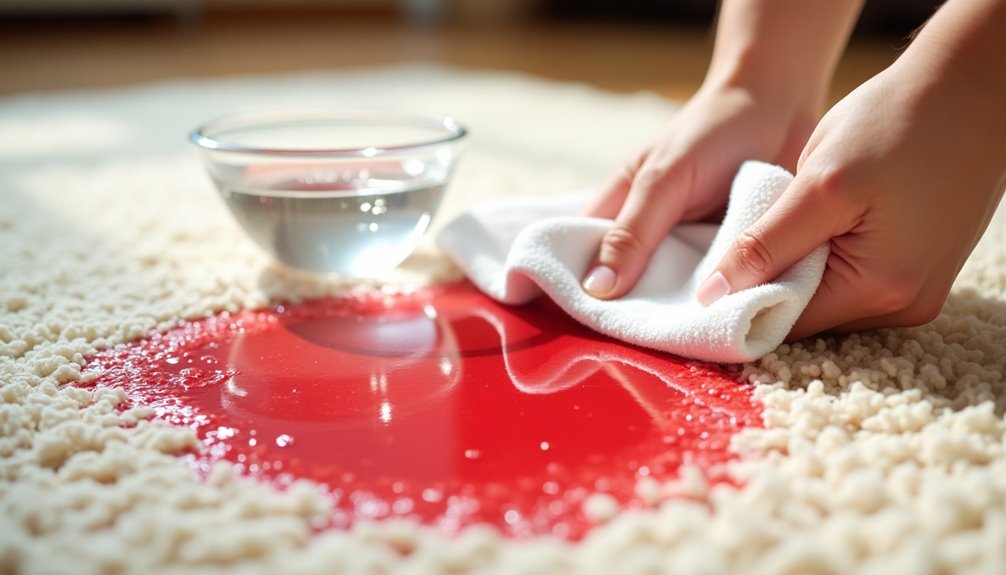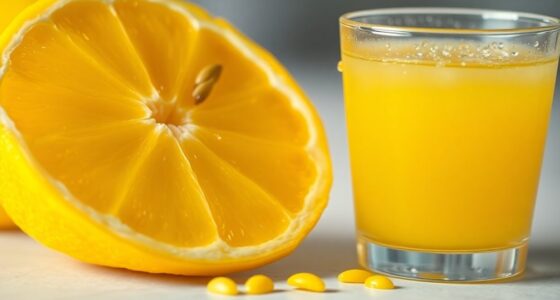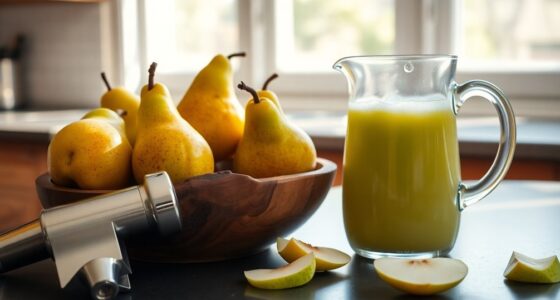When juice spills on your carpet, act fast! Blot the stain with a clean cloth to soak up as much as you can—don't rub it, or you could spread it. Mix 1 tablespoon of dish soap with 2 cups of warm water and dab it onto the stain. If it's stubborn, try a vinegar solution or even hydrogen peroxide as a last resort. Stick around to discover more effective tips for tackling those pesky stains!
Key Takeaways
- Act quickly to blot the juice stain with a clean cloth, absorbing as much liquid as possible without rubbing.
- Use a mixture of 1 tablespoon liquid dish soap and 2 cups warm water to treat the stained area.
- For stubborn stains, apply a solution of ½ cup white vinegar and ½ cup water, letting it sit for 10 minutes.
- Rinse the area thoroughly with cold water to remove any detergent or vinegar

Juice spills can quickly turn into stubborn stains on your carpet, but acting fast can make all the difference. The moment you notice a juice stain, grab a clean cloth or a damp paper towel and start blotting the area immediately. You'll want to absorb as much liquid as possible, so press down firmly but be careful not to rub, as that can spread the stain further. It's all about catching the spill before it settles into the fibers of your carpet.
Once you've blotted up the excess juice, it's time to reach for some cleaning solutions. A simple yet effective mix is to combine 1 tablespoon of liquid dish soap with 2 cups of warm water. Use a sponge to apply this solution to the stained area, dabbing repeatedly. Keep at it until you notice the stain lifting. The key is to remain patient and continue blotting until the juice stain starts to fade.
If the stain is proving particularly stubborn, you might need to step it up a notch. A mixture of ½ cup white vinegar and ½ cup water can work wonders on tougher stains. Apply this solution to the affected area and allow it to sit for at least 10 minutes. This waiting period enables the vinegar to break down the stain more effectively.
After the time's up, take a clean cloth or paper towel and gently blot the area again. You should start to see a significant difference in the stain's appearance.
After you've applied your cleaning solutions, don't forget to rinse the stained area thoroughly with cold water. This step is crucial as it helps remove any lingering detergent or vinegar residue that could cause further damage to your carpet. Use a clean damp cloth or sponge to rinse the area, and then blot it dry with a paper towel.
If, after all that, the juice stain is still hanging around, it's time to consider a bit more strength in your approach. You can use 3% hydrogen peroxide as a last resort. Apply it directly to the stain and cover the area with dry paper towels. Let it sit for about an hour, then come back and check the results. This method often works for those pesky stains that refuse to budge.
Cleaning juice out of your carpet doesn't have to be a daunting task. With quick action and the right cleaning solutions, you can tackle even the most stubborn stains. Just remember to blot, use gentle cleaning methods, and rinse the area well. Your carpet will thank you for the care you've taken to restore its cleanliness.
Frequently Asked Questions
How to Get Juice Out of the Carpet?
To get juice out of the carpet, start by quickly blotting the stain with a clean cloth to absorb as much liquid as possible. Once you’ve absorbed the excess liquid, mix a solution of mild dish soap and warm water. Use a clean cloth to apply the mixture to the stained area, gently blotting it until the stain lifts. For those looking for a complete guide to removing tough stains, learning the best techniques for cleaning juice stains from carpet can be incredibly helpful.
Then, mix one tablespoon of dishwashing detergent with two cups of warm water and apply it to the stain. Blot repeatedly until it lifts.
For tough stains, use equal parts white vinegar and water, letting it sit before blotting.
Rinse with cold water and dry thoroughly to remove any residue.
How Do You Clean up Spilled Juice?
When you spill juice, act quickly! First, grab a clean cloth or paper towel and blot the spill to absorb as much liquid as possible.
Don't rub, as that can spread the stain. Next, mix dishwashing detergent with warm water and apply it with a sponge, blotting until the stain lifts.
For tougher stains, try a vinegar-water solution. Finally, rinse the area with cold water and dry it with a clean towel.
How Do You Clean Spilled Liquid Out of Carpet?
When you clean spilled liquid out of carpet, start by blotting the stain with a clean cloth to absorb as much liquid as you can.
Don't rub, as that can spread the stain.
Next, mix a tablespoon of dishwashing detergent with two cups of warm water and apply it to the area with a sponge.
Rinse with cold water afterward to remove any residue, and blot dry with a towel for a clean finish.
What Absorbs Liquid Out of Carpet?
Did you know that up to 25% of carpet stains are liquid-based?
To absorb liquid from your carpet, start by blotting with a clean, dry cloth or paper towel. For larger spills, a wet vacuum works wonders.
If you have a sponge, soak it in cold water and press it firmly onto the stain. Club soda can help too, thanks to its carbonation.
Lastly, a warm water and dish soap mix can tackle sticky residues.
Conclusion
So, now you're a juice-cleaning maestro, ready to tackle any fruity disaster life throws at you! Who knew that getting grape juice out of your carpet could be your new party trick? Next time someone spills a drink, just smile knowingly and say, "No worries, I've got this!" Just remember, while you're busy saving your carpet, don't forget to enjoy the juice—preferably in a glass. Cheers to your newfound skills and a cleaner home!
Cindy thoroughly researches juicing trends, techniques, and recipes to provide readers with practical advice and inspiration. Her writing style is accessible, engaging, and designed to make complex concepts easy to understand. Cindy’s dedication to promoting the advantages of juicing shines through her work, empowering readers to make positive changes in their lives through the simple act of juicing.

















